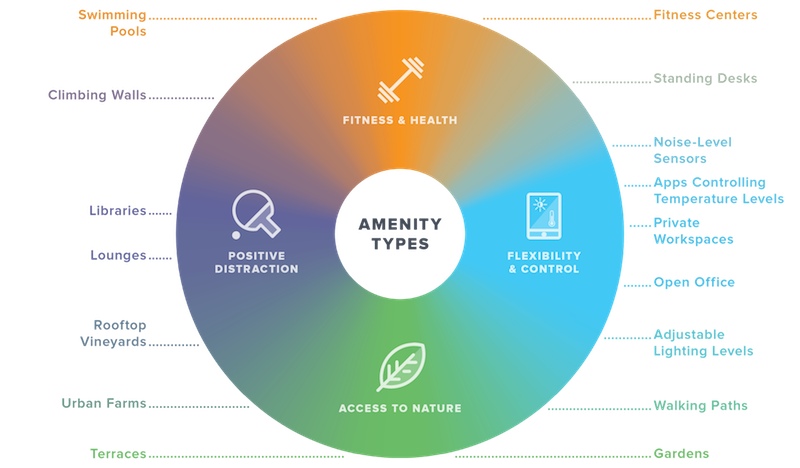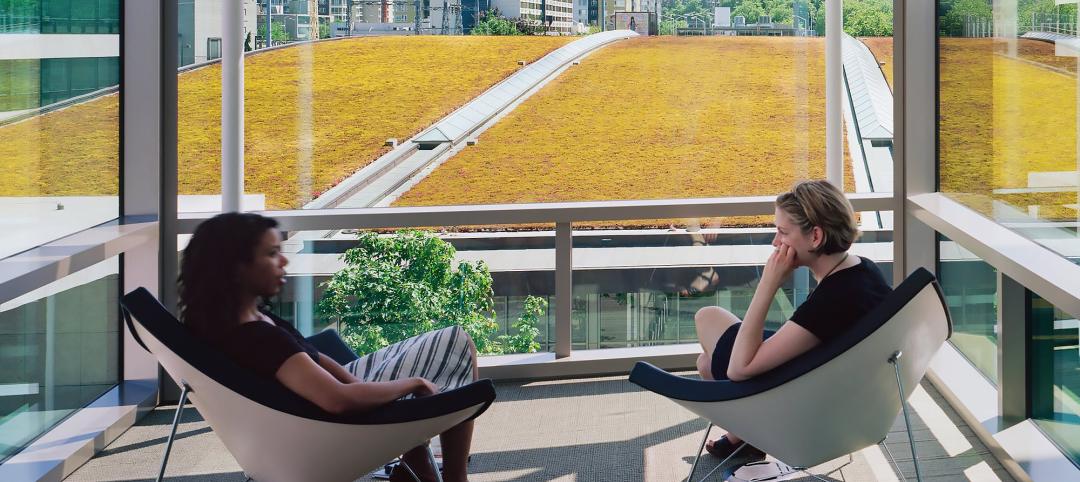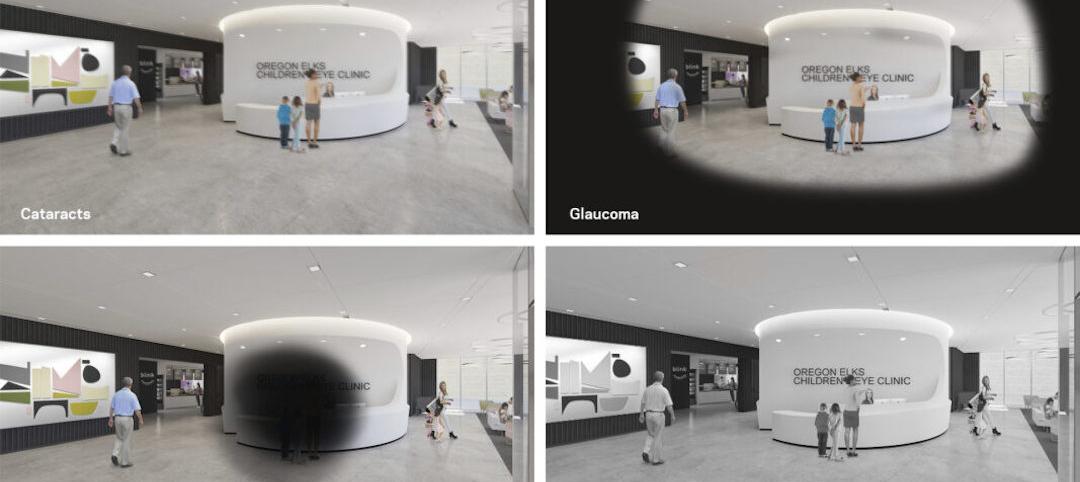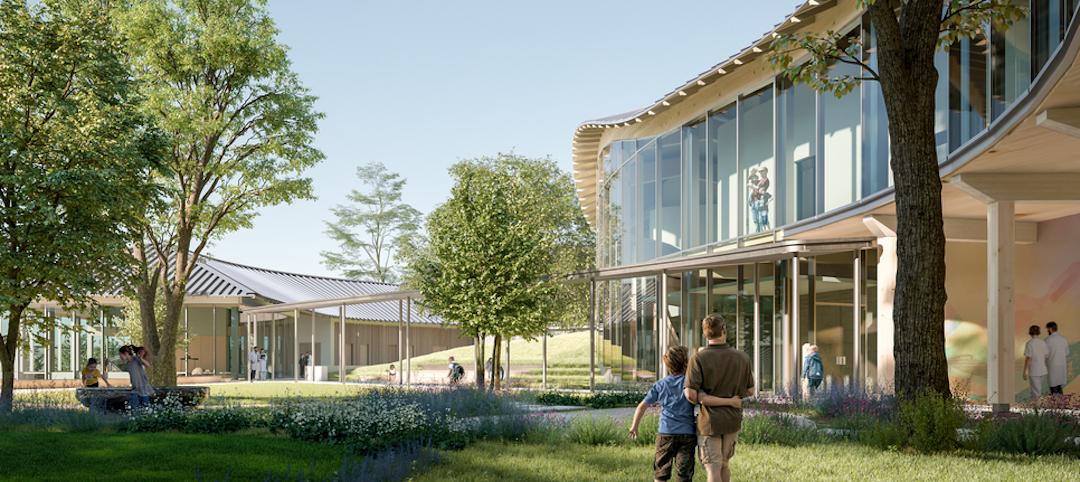As competition for tenants, patients, employees and students has intensified, amenities have become an important asset and differentiator across all building types. For example, the total amount of space devoted to amenities in commercial office buildings has risen from 3 percent to 12 percent for high-end tenants, while hospitals and higher education institutions have spent billions to create amenity-rich campuses. Amenities not only draw potential building users, but they also can have a positive impact in terms of asking rates, employee retention [PDF], patient satisfaction and patient outcomes.
While food service has become a baseline amenity in a wide range of facilities, four other amenity types are gaining popularity, namely, those which support fitness & health, access to nature, flexibility & control, and positive distraction.
Fitness & Health
Gyms are high on the list of employees’ desired amenities, particularly among millennials. In fact, three quarters of European employers already provide fitness facilities, expecting to benefit through reduced healthcare costs and improved productivity. Companies like Chesapeake Energy provide not just gyms but basketball courts and Olympic-sized swimming pools, while even coworking spaces like Brooklyn Boulders Somerville feature major fitness amenities like 22-foot climbing walls.
In healthcare, wellness and fitness centers have evolved from marketing gimmicks into profitable and popular amenities supporting integrated care and population health models. Akron General’s Health & Wellness Center–Green, for example, incorporates a fitness center with outpatient services and emergency department in a sprawling complex, while Florida Hospital is building an 80,000-square-foot wellness center that features indoor farmers’ markets.
Access to Nature
Green space is one of the most desired yet underprovided amenities in office buildings, according to surveys of millennials, and has a restorative effect on the weary. Some of the more innovative examples of green space amenities include multi-story glass spheres at Amazon’s new headquarters in Seattle, and a 43,000-square-foot urban farm at Pasona Group’s main offices in Tokyo.
Evidence-based design studies have also demonstrated that patients with a view of nature have less anxiety and pain [PDF], which has helped popularize healing gardens and other green amenities in the healthcare industry. For example, Diakonie-Klinikum Stuttgart has over 150,000 square feet of green space and gardens, while Massachusetts General Hospital’s Lunder Building has an atrium featuring hanging gardens.
Flexibility & Control
Employees that have a higher degree of control over where they work, including access to private space and a range of task-appropriate work environments, tend to have a higher degree of workplace engagement. Companies like ViaStat and Thermo Fisher Scientific have actively encouraged employees to modify and redesign their work environments to provide more flexibility and personal control.
Other studies have found that giving patients more personal control and choice reduces stress, an insight hospitals accommodate by creating relaxation rooms and enabling patients to control variables like lighting, sound and temperature. UCSD Jacobs Medical Center’s new facility gives patients iPads which control windows shades, room lights, the thermostat and an Apple TV.
Positive Distraction
Game and recreation areas have long been common in the tech industry but are becoming a more widespread phenomenon. These spaces may seem juvenile, but research suggests that helping people feel younger improves productivity. Other workplace amenities like lounges, libraries and terraces can help to create more varied, stimulating environments. Some more unusual examples include a mock pirate ship at Inventionland’s headquarters, and a 65-foot Ferris wheel at Acuity’s main offices.
Hospitals have invested in common spaces like lobbies and lounges to create areas of positive distraction and to reduce stress. At the Minnesota Health Clinics and Surgery Center, waiting spaces have discovery bars where patients can explore research and educational materials via iPads, while Lurie Children’s Hospital has a custom fire truck that kids can play in.
Research and anecdotal evidence suggest that amenities which support fitness & health, access to nature, flexibility & control and positive distraction can have tangible benefits. The right type of amenity can be not just a perk but an asset that contributes to the bottom line, whether it’s more engaged employees, better patient outcomes or more desirable properties.
More from Author
NBBJ | Oct 3, 2024
4 ways AI impacts building design beyond dramatic imagery
Kristen Forward, Design Technology Futures Leader, NBBJ, shows four ways the firm is using AI to generate value for its clients.
NBBJ | Jun 13, 2024
4 ways to transform old buildings into modern assets
As cities grow, their office inventories remain largely stagnant. Yet despite changes to the market—including the impact of hybrid work—opportunities still exist. Enter: “Midlife Metamorphosis.”
NBBJ | May 10, 2024
Nature as the city: Why it’s time for a new framework to guide development
NBBJ leaders Jonathan Ward and Margaret Montgomery explore five inspirational ideas they are actively integrating into projects to ensure more healthy, natural cities.
NBBJ | Oct 18, 2023
6 ways to integrate nature into the workplace
Integrating nature into the workplace is critical to the well-being of employees, teams and organizations. Yet despite its many benefits, incorporating nature in the built environment remains a challenge.
NBBJ | May 8, 2023
3 ways computational tools empower better decision-making
NBBJ explores three opportunities for the use of computational tools in urban planning projects.
NBBJ | Jan 17, 2023
Why the auto industry is key to designing healthier, more comfortable buildings
Peter Alspach of NBBJ shares how workplaces can benefit from a few automotive industry techniques.
NBBJ | Aug 4, 2022
To reduce disease and fight climate change, design buildings that breathe
Healthy air quality in buildings improves cognitive function and combats the spread of disease, but its implications for carbon reduction are perhaps the most important benefit.
NBBJ | Feb 11, 2022
How computer simulations of vision loss create more empathetic buildings for the visually impaired
Here is a look at four challenges identified from our research and how the design responds accordingly.
NBBJ | Jan 7, 2022
Supporting hope and healing
Five research-driven design strategies for pediatric behavioral health environments.
NBBJ | Nov 23, 2021
Why vertical hospitals might be the next frontier in healthcare design
In this article, we’ll explore the opportunities and challenges of high-rise hospital design, as well as the main ideas and themes we considered when designing the new medical facility for the heart of London.
















